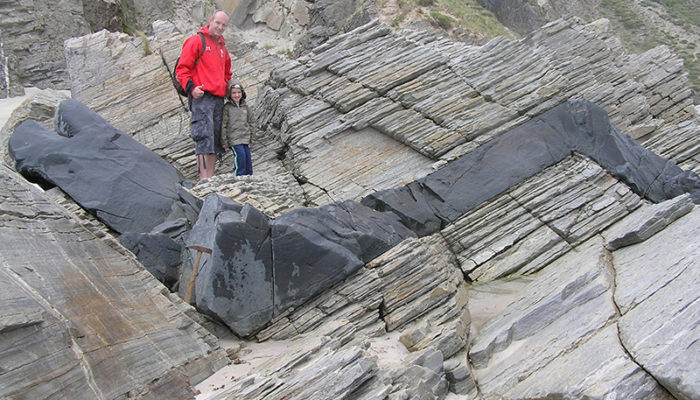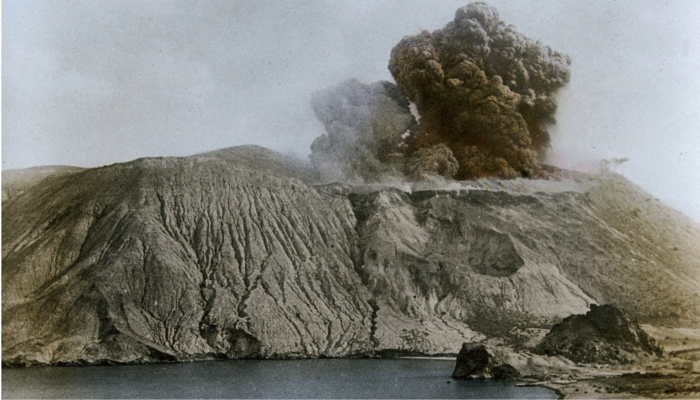For the first time in 2006 Cannat and co-workers described a smooth seafloor type in the mid-ocean ridge located in the SW Indian Ocean (SWIR). The 660-km-long off-axis bathymetry, gravity, and magnetic dataset presented in the study lies near the Rodrigues triple junction (RTJ in Fig. 1). The must read paper expanded the previous conceptual models that considered mid ocean ridges as primarily vol ...[Read More]
TS Must Read – Spatio-temporal evolution of strain accumulation derived from multi-scale observations of Late Jurassic rifting in the northern North Sea: A critical test of models for lithospheric extension, Cowie et al. (2005)
Cowie et al. (2005) is an exciting “must-read” for any geologist interested in rift systems. It examines strain accumulation and extension within a rift basin and scrutinizes model predictions with field observations. The authors highlight two sets of models, the first set of models uses brittle deformation to explain extension (e.g., King et al., 1988; Kusznir et al., 1991; Ter Voorde et al., 199 ...[Read More]
TS Must read – Wortel and Spakman (2000), Subduction and slab detachment in the Mediterranean-Carpathian region
The must read paper Wortel & Spakman (2000) uses seismic tomography models showing the three-dimensional upper mantle velocity structure of the Mediterranean-Carpathian region to hypothesize lithospheric processes related to slab detachment, and particularly, the lateral migration of the detachment along plate boundaries (Fig. 1). The paper defends that this process is a key control in the lit ...[Read More]
Geomythology. The Sicilian Trilogy – Part III: The Cyclopes, the Skeletons, and the Dwarfs Elephants
Strangers, who are you? Where do sail from? Are you traders, or do you sail the as rovers, with your hands against every man, and every man’s hand against you?” … “Stranger, you are a fool, or else you know nothing of this country. Talk to me, indeed, about fearing the gods or shunning their anger? We Cyclopes do not care about Jove or any of your blessed gods, for we are ever so much ...[Read More]
TS Must-Read – Yin and Harrison (2000) Geologic evolution of the Himalaya-Tibetan Orogen
Yin and Harrison (2000) puts together an exhaustive review of three decades of geological and geophysical investigations on the Himalayan-Tibetan orogen. This research supports the orogenesis started during the Cenozoic between 70 and 50 Ma ago as a consequence of the Indo-Asian collision following the closure of the Tethys ocean between Laurasia and Gondwana. Yin and Harrison (2000) underlines th ...[Read More]
Geomythology. The Sicilian Trilogy – Part II: Vulcano, Vulcan’s forge
Why is a fork actually called fork? And why are volcanoes actually called volcanoes? While I do not have any reply for the first question, I have one for the second… and with a quite interesting story. The Earth currently has around 1350 potentially active volcanoes, aside from the volcanoes along the spreading centres (USGS faq); all of them are named after a single volcano, called Vulcano. Vulca ...[Read More]
The ECS TS team, and their activities between GAs
As member of the EGU Tectonics and Structural Geology (TS) Early Career Scientist (ECS) Representative team, and with the outlook of the first hybrid EGU General Assembly (GA), I take the opportunity to highlight some of the activities and news of the ECS TS team. The ECS TS team has been very active all year round between last year’s #vEGU21 and the upcoming #EGU22 General Assembly. The activitie ...[Read More]
Features from the Field: Dikes and Sills

Volcanoes are everywhere along plate margins and on hot spots on the planet’s surface. Just in the past 2 years, we have witnessed enormous explosive eruptions such as that of the Hunga Tonga volcano which released an amount of energy equivalent to hundreds of atomic bombs, and massive lava flows, as at the Cumbre Vieja at La Palma, which was estimated to have a total volume of 80 million cubic me ...[Read More]
TS Must-Read – Brun (1999): Narrow rifts versus wide rifts: inferences for the mechanics of rifting from laboratory experiments
In 1999 Jean-Pierre Brun published his Must-Read paper about rifting, in which he reviews fifteen years of laboratory experiments at Geosciences Rennes. In a brief introduction the paper reminds the reader of the two main rift types: narrow rifting as the preceding stage for continental break-up, and wide rifting that occurs after cessation of convergence. The article introduces some key differenc ...[Read More]
TS Must Read – Scholz (1998): Earthquakes and friction laws
Scholz (1998) is the “must-read” review article about rate- and state- variable laws of rock friction. The article is a robust introduction to the state-of-the art of the discipline at the end of the past century and should be considered of particular interest for students and/or early career scientists. In spite of its relative simplicity, rock mechanics unfortunately is still not taught universa ...[Read More]




